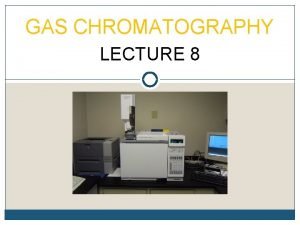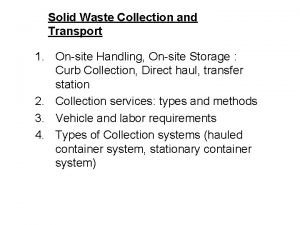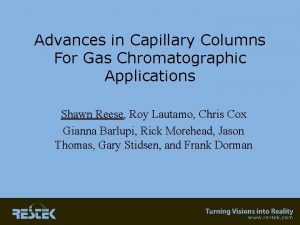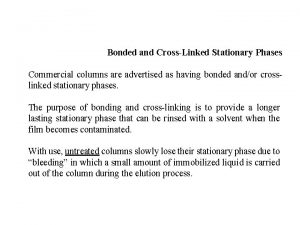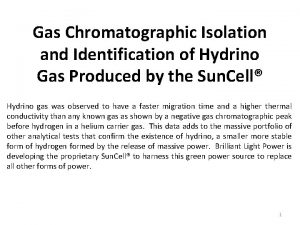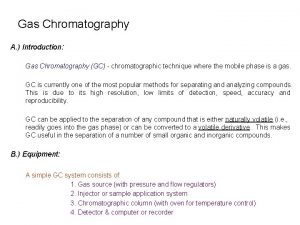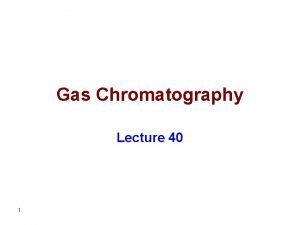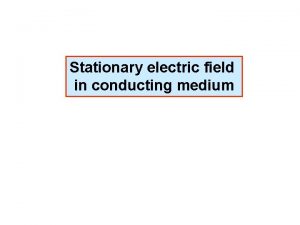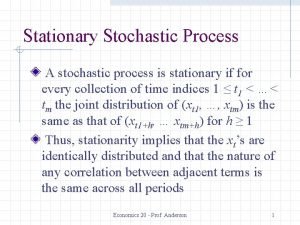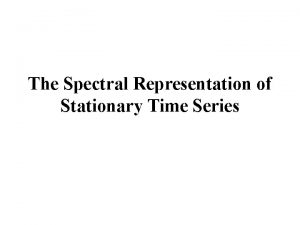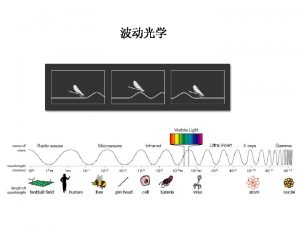Gas Chromatographic Columns and stationary phases The pioneering

































- Slides: 33

Gas Chromatographic Columns and stationary phases

The pioneering gas-liquid chromatographic studies in the early 1950 s were carried out on packed columns The stationary phase was a thin film of liquid retained by adsorption on the surface of a finely divided, inert solid support. From theoretical studies made during this early period, it became apparent that unpacked columns having inside diameters of a few tenths of a millimeter could provide separations that were superior to packed columns in both speed and column efficiency.

In such capillary columns, the stationary phase was a film of liquid a few tenths of a micrometer thick that uniformly coated the interior of a capillary tubing.

In the late 1950 s, such open tubular columns were constructed, and the predicted performance characteristics were experimentally confirmed in several laboratories, with open tubular columns having 300, 000 plates or more being described. Despite such spectacular performance characteristics, capillary columns did not gain widespread use until more than two decades after their invention.

The reasons for the delay were several, including q small sample capacities, q fragility of columns, q mechanical problems associated with sample introduction and connection of the column to the detector, q difficulties in coating the column reproducibly, q short lifetimes of poorly prepared columns, q tendencies of columns to clog, q and patents, which limited commercial development to a single manufacturer (the original patent expired in 1977).

The most significant development in capillary GC occurred in 1979 when fused-silica capillaries were introduced. Since then an impressive list of commercially available capillary columns for various applications has appeared. As a result, the majority of applications that have appeared in the past few years use capillary columns.

32 B-1 Capillary Columns Capillary columns are also called open tubular columns because of the open flow path through them. They are of two basic types: wall-coated open tubular (WCOT) and support-coated open tubular (SCOT). Wall-coated columns are capillary tubes coated with a thin layer of the liquid stationary phase.

In support-coated open tubular columns, the inner surface of the capillary is lined with a thin film (~30 µm) of a solid support material. Such as diatomaceous earth, on which the liquid stationary phase is adsorbed. This type of column holds several times as much stationary phase as does a wall-coated column and thus has a greater sample capacity.

Generally, the efficiency of a SCOT column is less than that of a WCOT column but significantly greater than that of a packed column. Early WCOT columns were constructed of stainless steel, aluminum, copper, or plastic. Subsequently, glass was used. Often, an alkali or borosilicate glass was leached with gaseous hydrochloric acid, strong aqueous hydrochloric acid, or potassium hydrogen fluoride to give an inert surface. Subsequent etching roughened the surface, which bonded the stationary phase more tightly.

Fused-silica open tubular (FSOT) columns are currently the most widely used GC columns. Fused-silica capillaries are drawn from specially purified silica that contain minimal amounts of metal oxides.

These capillaries have much thinner walls than their glass counterparts. They are given added strength by an outside protective polyimide coating, which is applied as the capillary tubing is being drawn. The resulting columns are quite flexible and can be bent into coils with diameters of a few inches.

Figure 32 -7 shows a picture of fused-silica capillary columns. Commercial fusedsilica columns offer several important advantages over glass columns, such as physical strength, much lower reactivity toward sample components, and flexibility. For most applications, they have replaced the older type WCOT glass columns.

Fused-silica columns with inside diameters of 0. 32 and 0. 25 mm are very popular. Higher-resolution columns are also sold with diameters of 0. 20 and 0. 15 mm. Such columns are more troublesome to use and are more demanding on the injection and detection systems.

Thus, a sample splitter must be used to reduce the size of the sample injected onto the column, and a more sensitive detector system with a rapid response time is required. Capillary columns with 530 µm inside diameters, sometimes called megabore columns, are also available commercially. These columns will tolerate sample sizes that are similar to those for packed columns.

The performance characteristics of megabore capillary columns are not as good as those of smaller diameter columns but significantly better than those of packed columns. Table 32 -2 compares the performance characteristics of fusedsilica capillary columns with other types of wall-coated columns as well as with support-coated and packed columns.


32 B-2 Packed columns Modern packed columns are fabricated from glass or metal tubing. They are typically 2 to 3 m long and have inside diameters of 2 to 4 mm. These tubes are densely packed with a uniform, finely divided packing material, or solid support, that is coated with a thin layer (0. 05 to 1 µm) of the stationary liquid phase. The tubes are usually formed as coils with diameters of roughly 15 cm so that they can be conveniently placed in a temperaturecontrolled oven.

Solid Support Materials The packing, or solid support, in a packed column serves to hold the liquid stationary phase in place so that as large a surface area as possible is exposed to the mobile phase. The ideal support consists of small, uniform, spherical particles with good mechanical strength and a specific surface area of at least 1 m 2/g. In addition, the material should be inert at elevated temperatures and be uniformly wetted by the liquid phase.

No substance that meets all of these criteria perfectly is yet available. The earliest, and still the most widely used, packings for gas chromatography were prepared from naturally occurring diatomaceous earth, Diatomaceous earth is made of silicon dioxide, It's also known as amorphous silica and silica powder among other names. The name diatomaceous earth refers to the source of the material as a powder made up of the crushed fossilized skeletons of prehistoric creatures. Both coarse and fine ground diatomaceous earth is available as a food grade substance. which consists of the skeletons of thousands of species of singlecelled plants that inhabited ancient lakes and seas (Fig. 32 -12, an enlarged photo of a diatom obtained with a scanning electron microscope).

Figure 32 -12 A photomicrograph of a diatom. Magnification 5000 x.

These support materials are often treated chemically with dimethyldichlorosilane, which gives a surface layer of methyl groups. This treatment reduces the tendency of the packing to adsorb polar molecules.

Particle Size of Supports The efficiency of a gas chromatographic column increases rapidly with decreasing particle diameter of the packing. The pressure difference required to maintain an acceptable flow rate of carrier gas, however, varies inversely as the square of the particle diameter.

The latter relationship has placed lower limits on the size of particles used in gas chromatography because it is not convenient to use pressure differences that are greater than about 50 psi. As a result, the usual support particles are 60 to 80 mesh (250 to 170 µm) or 80 to 100 mesh (170 to 149 µm).

32 B-3 Liquid Stationary Phases Desirable properties for the immobilized liquid phase in a gasliquid chromatographic column include (1) low volatility (ideally, the boiling point of the liquid should be at least 100 o. C higher than the maximum operating temperature for the column), (2) thermal stability, (3) chemical inertness, and (4) solvent characteristics such that k and α, values for the solutes to be resolved fall within a suitable range. Many liquids have been proposed as stationary phases in the development of gas-liquid chromatography. Currently, fewer than a dozen are commonly used.

The proper choice of stationary phase is often crucial to the success of a separation. The retention time for an analyte on a column depends on its distribution constant, which in turn is related to the chemical nature of the liquid stationary phase.

To separate various sample components, their distribution constants must be sufficiently different to accomplish a clean separation. At the same time, these constants must not be extremely large or extremely small because large distribution constants lead to prohibitively long retention times and small constants produce such short retention times that separations are incomplete. To have a reasonable residence time on the column, an analyte must show some degree of compatibility (solubility) with the stationary phase.

The principle of “like dissolves like” applies, where “like” refers to the polarities of the analyte and the immobilized liquid. The polarity of a molecule, as indicated by its dipole moment, is a measure of the electric field produced by separation of charge within the molecule. Polar stationary phases contain functional groups such as CN, CO, and OH.

Hydrocarbon-type stationary phases and dialkyl siloxanes are nonpolar, whereas polyester phases are highly polar. Polar analytes include alcohols, acids, and amines; solutes of medium polarity include ethers, ketones, and aldehydes. Saturated hydrocarbons are nonpolar. Generally, the polarity of the stationary phase should match that of the sample components. When the match is good, the order of elution is determined by the boiling point of the eluents.

The polarities of common organic functional groups in increasing order are as follows: aliphatic hydrocarbons, olefins, aromatic hydrocarbons, halides, sulfides, ethers, nitro compounds, esters, aldehydes, ketones, alcohols, amines, sulfoxides, amides, carboxylic acids, water.

Some Widely Used Stationary Phases Table 32 -3 lists the most widely used stationary phases for both packed and open tubular column gas chromatography in order of increasing polarity. These six liquids can probably provide satisfactory separations for 90% or more of samples. Five of the liquids listed in Table 32 -3 are polydimethyl siloxanes that have the general structure


In the first of these, polydimethyl siloxane, the R groups are all CH 3 giving a liquid that is relatively nonpolar. In the other polysiloxanes shown in the table, a fraction of the methyl groups are replaced by functional groups such as phenyl (C 6 H 5), cyanopropyl (C 3 H 6 CN), and trifluoropropyl (C 3 H 6 CF 3). The percentages listed before some of the stationary phases in Table 32 -3 give the amount of substitution of the named group for methyl groups on the polysiloxane backbone.

Thus, for example, 5% phenyl polydimethyl siloxane has a phenyl ring bonded to 5% (by number) of the silicon atoms in the polymer. These substitutions increase the polarity of the liquids to various degrees. The fifth entry in Table 32 -3 is a polyethylene glycol with the structure It finds widespread use for separating polar species.
 The pioneering age of film was started in the year
The pioneering age of film was started in the year Pioneering age of film
Pioneering age of film Pioneering americans marooned by geography
Pioneering americans marooned by geography Fid detector principle
Fid detector principle Chromatography mobile phase and stationary phase
Chromatography mobile phase and stationary phase Differences between ideal gas and real gas
Differences between ideal gas and real gas Difference between ideal gas and real gas
Difference between ideal gas and real gas The father of the periodic table is
The father of the periodic table is Horizontal rows in the periodic table
Horizontal rows in the periodic table Period/row
Period/row Short column definition
Short column definition Displays information in rows and columns
Displays information in rows and columns Gordon formula for columns
Gordon formula for columns Homozygous letters
Homozygous letters Matlab switch rows and columns
Matlab switch rows and columns Two-dimensional structure composed of rows and columns
Two-dimensional structure composed of rows and columns Two-dimensional structure composed of rows and columns
Two-dimensional structure composed of rows and columns Ideal gas vs perfect gas
Ideal gas vs perfect gas An ideal gas is an imaginary gas
An ideal gas is an imaginary gas Sutherland's law
Sutherland's law Reason of bhopal gas tragedy
Reason of bhopal gas tragedy Gas leaked in bhopal gas tragedy
Gas leaked in bhopal gas tragedy Volume molare
Volume molare Flue gas desulfurisation gas filter
Flue gas desulfurisation gas filter Poisonous gas leaked in bhopal gas tragedy
Poisonous gas leaked in bhopal gas tragedy Contoh soal kinetika kimia orde 1
Contoh soal kinetika kimia orde 1 Gas exchange key events in gas exchange
Gas exchange key events in gas exchange Tilt frame container system
Tilt frame container system What's the world's population
What's the world's population Mobile phase and stationary phase
Mobile phase and stationary phase Jointly stationary and ergodic process
Jointly stationary and ergodic process Stationary and mobile sources of air pollution
Stationary and mobile sources of air pollution Advantages of stationary container system
Advantages of stationary container system Chromatography mobile phase and stationary phase
Chromatography mobile phase and stationary phase



